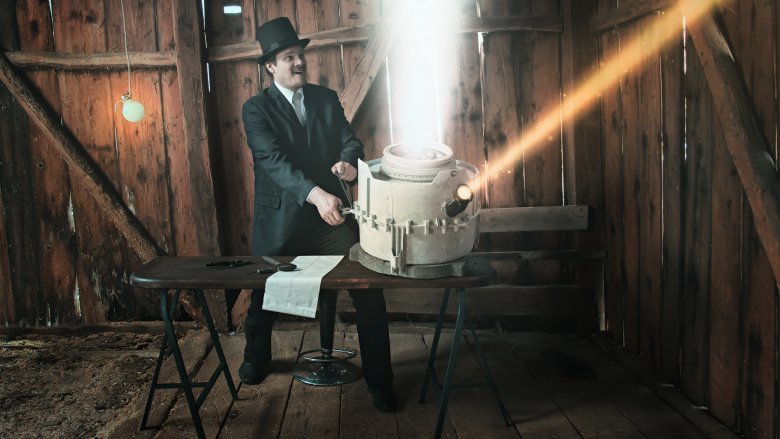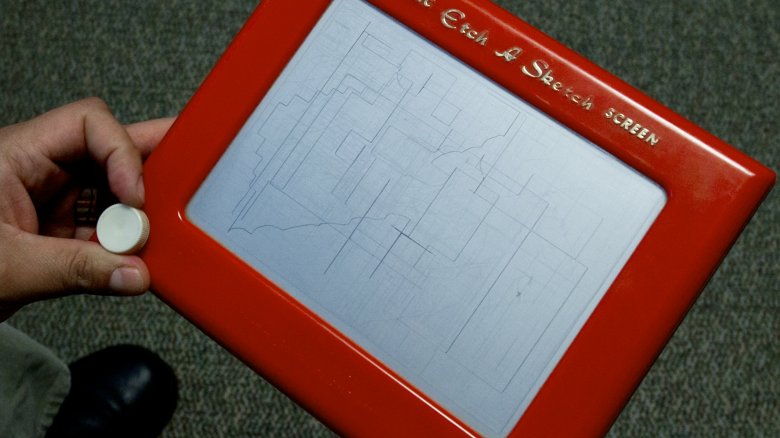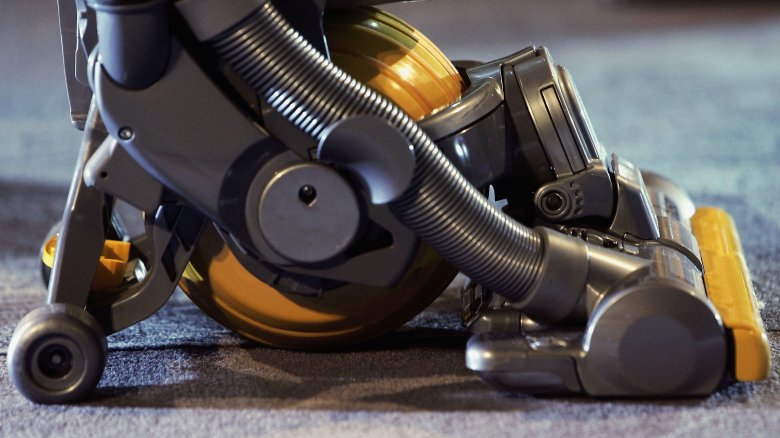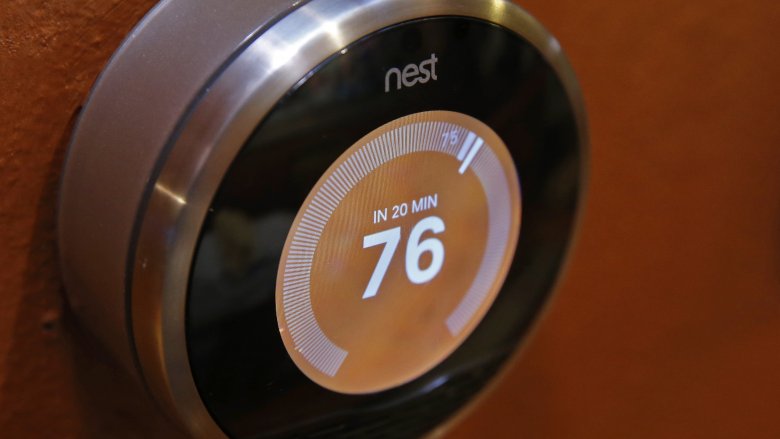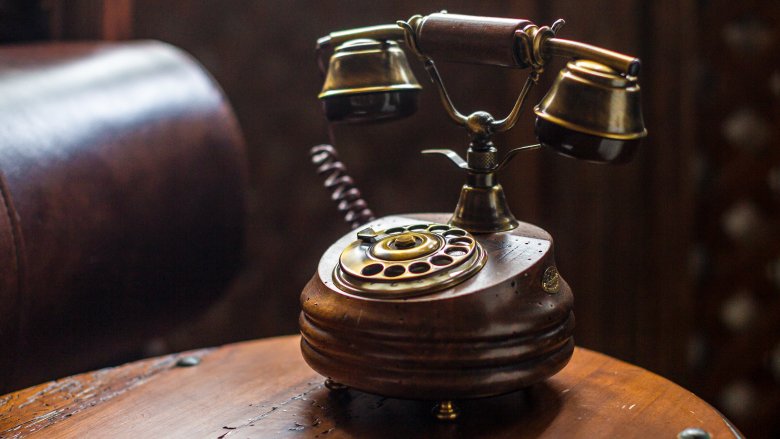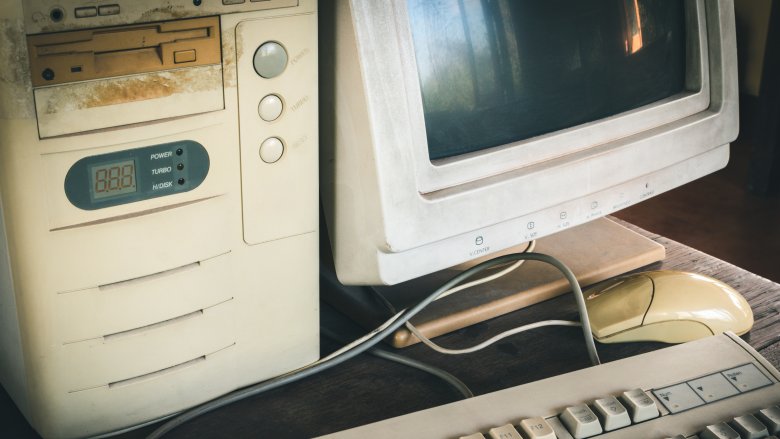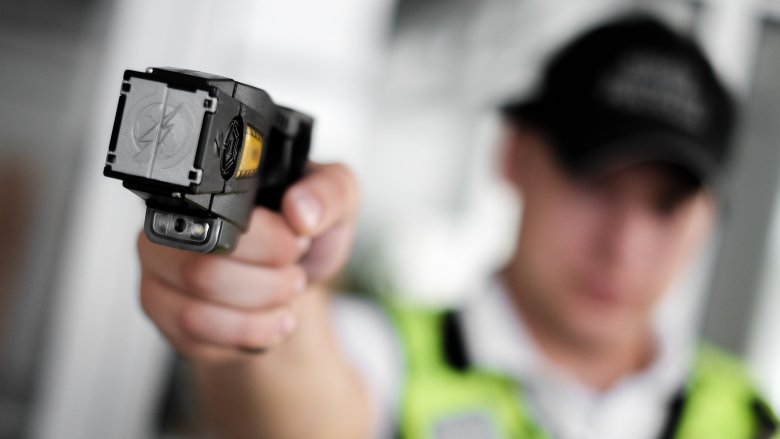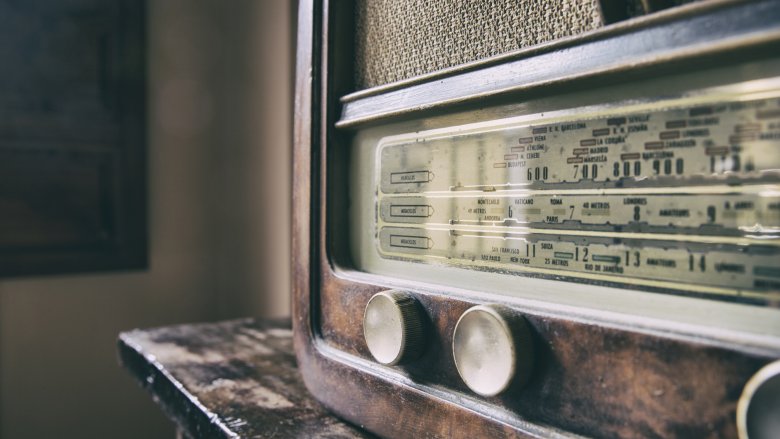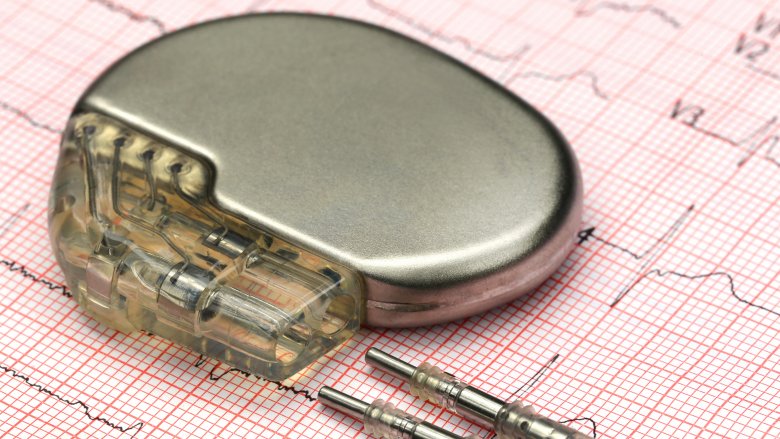Great Inventions That Were Made In Garages
Everyone knows if you want to invent something that will change the world, you have to have a garage. The American garage is the scaffolding of great innovation, a quiet place where genius can flourish, and (depending on your climate) maybe the room where you do your laundry and feed your cat. According to legend, once, long ago, people used to park their cars in garages, too.
Some of the world's most impactful products were invented in garages, which are sort of obvious places for young inventors to make things happen because you don't need to rent them and when it's 4 a.m. and you realize that you've been fashioning toilet brush prototypes nonstop all night long, you don't have to crawl very far to find your bed.
So what if you don't have a garage? Can you still bring your genius new toilet brush, self-driving lawn mower, or robot dog walker to the world market? No. You really need a garage to get your invention going.
This childhood icon of frustration
Just about everyone remembers the beloved Etch-A-Sketch, that super annoying toy you always ended up hurling across the room because you forgot which way you had to turn the dial to make the line go where you wanted it to and you just totally messed up the drawing you'd been working on for the last hour because there isn't any way to erase only the line you accidentally drew that's going left instead of right.
Anyway, that traumatizing icon of childhood was not designed at the corporate headquarters of a toy company but in someone's garage. According to the V&A Museum of Childhood, French inventor Arthur Granjean called his creation "L'Ecran Magique," which means "The Magic Screen," and he thought it was cool because it was a drawing toy that did not require batteries and did not come with a bunch of pens that would be all dried out in the first 48 hours because pen caps are too complicated for children's brains.
The Etch-A-Sketch was first shown at the International Toy Fair in Nuremberg in 1959, but no one really thought it was that awesome (maybe execs kept forgetting which way to turn the dial) until the Ohio Art Company picked it up and started mass producing it in 1960. Now, it's an icon. A monument to all things that were annoying about your childhood. But you'll probably still get one for your kids, because nostalgia.
This vacuum cleaner they promised would never lose suction
James Dyson is best known for inventing vacuum cleaners that "never lose suction," even though they totally do, but okay. His garage-invention story is almost as famous as his vacuum cleaner — according to GQ, Dyson's wife supported him for five years while he created not 10 or 20 prototypes of his product but 5,127. So perhaps the most miraculous part of this story is not that he actually created a product that made him a lot of money but that his wife didn't get sick of the whole enterprise after six months or so and tell him to just get a job, already. And also, 5,127 prototypes, really? Isn't that sort of close to, you know, if you put a bunch of monkeys in a garage with some tools and leave them there for five years with a bottomless supply of bananas, after around 5,127 prototypes eventually they will invent a vacuum cleaner? And something about those numbers doesn't add up — if he was in that garage for five years and he built 5,127 prototypes, isn't that like one new prototype every three days?
Anyway, no one will ever really know what went on in that garage, but today the Dyson company sits on 56 acres of land and has a few thousand employees, so whatever he did worked out pretty well for him, and hopefully also for his wife, who was probably the one stuck cleaning up after all the monkeys.
This thermostat that makes it easier for your family to mess with you
Did you know that the guy who invented the iPod also invented the Nest thermostat? It's true. In a Silicon Valley garage, Matt Rogers, pioneer of the device that forever empowered teenagers to sit in the back seats of their parents' cars and not have to participate in a conversation, also invented a device that would make it a lot easier for family members to annoy each other by secretly adjusting the temperature of the house to whatever range is more comfortable for them and less comfortable for everyone else and then not admitting to it. Technology is a beautiful thing.
Anyway according to Tech Crunch, Rogers quit his job at Apple in 2010 and rented a Palo Alto garage, and then somehow convinced 10 people to quit their high-paying Silicon Valley jobs and come work for him for free, seven days a week, 12 hours a day for six months. Fortunately for Rogers, he was able to find enough people with the vision to understand that annoying family members with remote thermostat adjustment was the way of the future. Today, Nest products can be found at all the major tech stores, including Apple.
It's a magical tale of people who are independently wealthy and can work without pay for a half a year so they can become even more independently wealthy. Doesn't that just give you the warm fuzzies? If it doesn't, you can turn up the heat a little bit.
This Internet icon that made time-wasting a way of life
One thing no one ever seems to do in a Silicon Valley garage is, you know, park a car. Or do a load of laundry. Or feed the cat. Normal people things don't seem to have a place in the average Silicon Valley garage, where all sorts of high-tech products were born, including everyone's favorite search engine: Google. That's right, if it weren't for Silicon Valley entrepreneurs and their remarkable capacity for not using garages for their intended purposes, you would not be able to waste several hours a day Googling cat memes, "Can you eat a flamingo," and "Is Neil Patrick Harris gay?" (Answers: 180 million, yes but it's illegal, and yes but what do you care?)
Now, according to Google's own backstory, the company actually got its start in a pair of Stanford University dorm rooms, but its first office was a garage in suburban Menlo Park, California, where a lot of the real innovations were made — things like making sure the actual result you were looking for is buried on page 10 and giving you hotel listings in Suffolk, Virginia, when it knows perfectly well you're in the U.K. Still, hey, what would the world be like without cat memes? What a horrifying thought.
This communication device that preceded the iPhone
Before there was the garage there was the carriage house, and even though it was meant to house buggies and harnesses instead of Chevys and all the tools required to repair Chevys because Chevys suck, it was still a place of innovation for a lot of enterprising people.
Alexander Graham Bell did a lot of his tinkering in a carriage house in Ontario, Canada. And although that famous first voice call was made in a Boston boarding house, the Parks Canada Agency says a lot of Bell's early work on the telephone happened in that Canadian carriage house, including the world's first long-distance phone call.
That wasn't Bell's only carriage house laboratory, though — he also had one in D.C. behind his father's home, which was eventually converted into a three-bedroom, three-bath residence. It was recently for sale, too, so that's cool. For a mere $2 million, some lucky history buff got to move into his or her own little piece of history. And for that price, we hope it at least came with a couple of prototype telephones.
Not the Apple computer, though
One of the most beloved Silicon Valley legends is the one about Apple computer and the garage it was invented in. But alas, it isn't true.
In 2014, Apple co-founder Steve Wozniak told Businessweek that although there was a garage, no actual inventing happened there. "We did no designs there, no breadboarding, no prototyping, no planning of products. We did no manufacturing there." What's left? Washing the co-founders' laundry? Because surely they didn't park any cars in it or anything.
Don't worry, though, the whole "personal computer was invented in a garage" legend still has elements of truth in it. Back in 1938, Dave and Lucille Packard were renting the first floor of a house and the adjacent garage for $45 a month, and their buddy Bill Hewlett moved into a little shack next door. Hewlett and Packard formed their legendary partnership in that garage. They didn't design personal computers exactly (because it was the 1930s), but they did invent an oscillator that they later sold to Disney, and their company later grew to be one of the giants in the personal computing industry. But the very first official personal computer, according to the Computer History Museum, was the Kenbak-1, which was built in 1971, had 256 bytes of memory, and predated the microprocessor. The Kenbak was invented in founder John Blankenbaker's garage, but clearly, everyone around Blankenbaker lacked his vision because the company folded two years later after selling only 40 computers.
This missile. Yes, a missile.
Just in case you thought it was only boring, change-the-world-for-the-better sorts of things that get invented in garages, take heart. Doomsday stuff can be (and has been) invented in garages, too. The most famous mad-scientist, destroy-my-enemies garage invention is the Sidewinder missile, which was rather shockingly not invented in a military-industrial complex where there is 24-hour surveillance, armed patrols, and mandatory security clearance for every single person who walks through the metal detectors. Nope. According to the Defense Media Network, the Sidewinder missile was invented in (wait for it) not one but "a couple of" garages.
Security precautions be damned, the engineers who designed the Sidewinder did the majority of their work in their own garages, and they even used their own cars to test the guidance system, though hopefully they stopped just short of doing this with actual guided projectiles. It does all sound rather Mythbusterish, though, so we would not be surprised to hear that something blew up at some point.
This was 60 years ago, though, so let's hope that the military's support of garage-engineered lethal weapons is now comfortably in the past.
This glue that lets you decoupage literally anything
So there are plenty of stories about world-changing things that were invented in garages, and also vacuum cleaners, because although a vacuum cleaner won't change the world it will definitely make it a lot less dusty. So there's world-changing and world-tidying, but outranking all of those things is Mod Podge, which is world-gluing. Or something. Basically, it's the product that finally gives all humans the freedom to slather glue all over stuff and have it dry clear. Where would humans be without Mod Podge? There'd be a lot less content on Pinterest, that's for sure.
Anyway, according to Martha Stewart (because of course Martha Stewart), Mod Podge was invented in the garage of Jan Wetstone, who wanted a product that would make decoupage a less laborious and time-consuming process. She not only designed Mod Podge in her garage, she also proved its worthiness in her garage when she used her brand-new invention to decoupage a Volkswagen Beetle. Today you can still buy Mod Podge at any craft store, though we don't really recommend using it to decoupage whole cars because it costs like $7 a pound, and a pound really doesn't go very far.
This non-lethal weapon
Okay, so it's not a Sidewinder missile, but it does have the power to mess you up, and it was (surprise!) invented in a garage. The modern stun gun arrived in 1999, and leaving aside the part where it totally sucks to get tased, you can think of it as a life-saving invention since it's allowed police to, in some situations replace lethal force with non-lethal force.
According to Reuters, the Taser was perfected by a guy named Rick Smith, but the idea came from Jack Cover, a retired NASA scientist who invented an early stun gun and also provided the garage for the project. What's kind of sketchy about the whole thing, though, is that 1999 wasn't really that long ago, and yet this was a device that was designed to incapacitate an adult human — potentially dangerous, especially in the development stages — and that it was designed and tested under kind of primitive circumstances. Smith and Cover's early test subjects consisted of a pig, five dogs, and actual human police officers who volunteered themselves in exchange for free beer. Sigh. At least it wasn't free doughnuts because the world couldn't handle that much stereotyping.
Tasers aren't entirely safe — early testing showed there were cardiac risks, though 1 million Tasers later and police say that there haven't been any confirmed cases of Taser-induced cardiac arrest. Lots of scientists and doctors say otherwise. Still, it beats an actual gun, at least.
This new-fangled way of selling things (and also radio)
The garage was the forefather of radio, and also the forefather of advertising, so the next time you have to sit through a FarmersOnly.com commercial you can thank your stupid garage for making it all possible.
According to Pittsburgh Music History, the first radio station was launched in 1916, when an amateur radio operator named Frank Conrad built a 75-watt transmitter in his Pennsylvania garage and then used it to broadcast music to a small audience of ham radio enthusiasts. Not long after that, Conrad blessed the world with the first broadcast commercial, when he offered to mention the local music store on air as exchange for free records, thus paving the way for FarmersOnly.com to insert their stupid little ditty into your brain where it will play on repeat for days.
The concept of broadcast radio caught on quickly, and so did the concept of commercial advertising, and today we live in a world where every human can join together in unison to sing "Nationwide is on your side," because even though we all have DVRs we still, for some reason, know that jingle by heart.
This device that lets your coworkers and everyone else in the world know who you're talking to
What could have a greater impact on the well-being of humanity than the speaker phone? Yes, the speaker phone is the genius invention that finally gave human beings the ability to simultaneously have a telephone conversation while also pacing the room and waving their arms around. Today, we all know the joys of listening to both sides of a phone call because holding a phone up to your ear is haaard.
According to Venture Beat, the speaker phone was only one of Walter L. Shaw's many inventions — he also invented the touch-tone phone, call forwarding, conference calling, and the "blue box," which basically let criminals make unmonitored long distance calls for free. But the speaker phone was the one he invented in his garage, and when he demoed it to AT&T in 1948 they were so excited that they asked him to sign a contract wherein all his past, present, and future innovations would belong exclusively to them. He said "no," so AT&T just kind of sat back and waited 14 years for the patents to expire.
So in the end, the poor dude ended up broke and living in a bus station and only avoided dying penniless because his son found him and gave him a place to live. The moral of this story: Anyone can invent cool things in a garage, but not every cool thing invented in a garage makes its inventor rich.
This medical device that lets heart patients not be plugged into walls anymore
So generally speaking it's kind of sketchy to invent weapons (non-lethal or otherwise) in a garage and it kind of seems sketchy to invent medical devices in a garage, too, but at least when your weapon prototype gets jammed up with some cat food or laundry lint it will just fail to do the business of killing people. When that happens to your medical device, it could be the end of whatever sheep or human being you're testing it on. Fortunately, that did not happen when Earl Bakken invented the first battery-powered, wearable pacemaker in his garage. To his credit, Bakken didn't get any cat food in his prototype, which he designed at the request of a surgeon who'd recently realized that a blackout would be a very bad day for anyone dependent on the sort of pacemaker you have to plug into a wall.
According to the New York Times, that first portable pacemaker eventually turned into a $30 billion company, which is now the largest medical device company in the world. Today Medtronic — which Bakken co-founded with his brother-in-law — employs 86,000 people, most of whom are not inventing things in garages.
